Genre: Action Developer: Sega Enterprises Publisher: Sega Enterprises Players: 1 Released: 1990
Can you survive eight mega of incredible danger? So reads the back of the box to Strider, one title that sparks bittersweet remarks from most gamers whenever it’s brought up. It’s not that people don’t like the game; far from it. Most people I’ve spoken to praise Sega’s effort at porting the monster Capcom hit to the Genesis. No one complains about the dumbed-down sounds, lack of frames of animation, missing backgrounds, or flicker and slowdown. Nope, it’s the changes between the American and Japanese versions of the port that tick people off. Strange how that works.
When Sega decided to convert Strider, it was a daunting task. Weighing in at a hefty eight megs, it was the first cart of that size to ever be released on a home console outside of anything Neo Geo. In order to maintain everything that made the coin-op original so popular, Sega had to squeeze every iota of memory they could from the ROM. For all intents and purposes, it was a resounding success, even if the game retailed for about $10 than others at the time (hey, it was 8 megs!).
Through five stages of action, Hiryu battles the Grand Master’s minions; it seems they’re everywhere. From snowy mountain tops to a steamy jungle, the pace of the game never lets up. I found it to emulate the feel and style of its arcade sibling quite well. Heck, even the flicker in stage four is there. The monkey robot did have some nasty breakup that wasn’t present in the original but this didn’t affect the game play at all. The graphics are very accurate on the Genesis and all the levels are there. I actually prefer Hiryu’s sprite from the port over the arcade, as he seems to have bulked up a bit and grown some hair.
Strider on Genesis is greatly different from the version released for the NES. Gone are the items and power ups, computer disks, and teleporters. The arcade rev is pure, straight-up action. Hiryu still has his trademark plasma sword and although he’s been a bit short-changed in the armament department, he still has some slick moves to get him through. Two life-giving power ups (spelling “Hi” and ryu”) either replenish your energy or add a bar to it, and there is also some momentary invincibility to find. 1ups occasionally pop up but you have to know where to look for them.
The Strider is quite the acrobat as well, using his sickle to cling to surfaces so he can pull himself up to higher ledges and climb walls. He also has a neat little slide which is quite useful for getting out of tight spots when enemies surround you. There aren’t too many moves outside of that, however, since you mostly rely on hacking down anything in your path to proceed.
Graphically, this game shines very brightly. Still able to hold up well today, the level of detail is excellent and in some places actually better than the arcade. Perhaps the Genesis’ smaller color palate and more profound use of shadow has something to do with it but I find that everything seems more alive in this port. There have been some compromises, as some levels (level four for instance) have lost a lot in their backgrounds. The strings of flesh dangling from the Apatosaurus skeleton were awesome and now they’re simply gone altogether. Pity.
The tunes are very Capcom-esque and continue the style and quality of many of the other games released by the publisher at the time. There’s something about Capcom music that you can recognize a mile away. Many of the themes are very well written, and I especially like “introduction 4” which is a stirring rendition of the Grand Master’s theme and plays during one of the many cut scenes that are spattered throughout the game. Each song is very well suited for its stage and sounds crystal clear.
I’m not as enthusiastic about the sound effects, as they are low and not really noticeable. It’s kind of strange to slice an enemy in half and hear nothing but a dull “shing!” as his torso goes flying. Explosions are muted as well and tend to take away some of the impact the wonderfully detailed graphics have.
Strider is short; very short. We’re talking about twenty minutes play time, tops. Not a good thing for a game that debuted at almost $80. Still, it’s a fun ride while it lasts and I find myself going back to it periodically. I do miss the dramatic “All sons of old gods…die!” voice over that played as the millipede carried you to the final battle with the Grand Master, but other than that (and some sword-swinging animations), there really isn’t much of a difference between the import and domestic versions. Either one is a great purchase and can be had for a great price. I lean towards the import for its cool box art (the domestic art is horrible) myself. Great graphics, sound, and gameplay make Strider a winner, no matter what region you buy it for.
SCORE: 9 out of 10

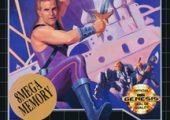
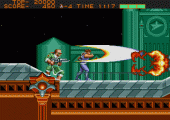
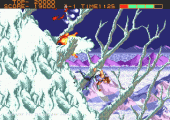
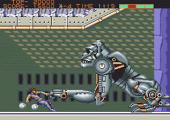
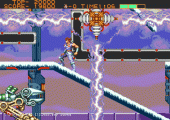
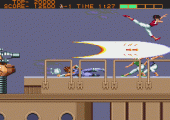
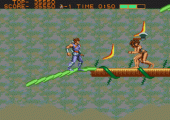
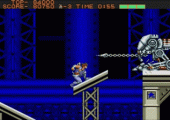
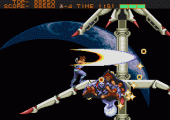
yep still pretty damn good. Looks and sounds great, the Soviet levels are a cool blast from the past, at one point you get your own pet Ravage following you around like Shadow Dancer; and the gravity core is maybe my favourite boss fight on the Genesis.
Strider remains one of the best Action-Platformers of all time. The level design and gameplay are perfectly in sync to create an experience of constant motion and action throughout the game that select few games even approach. The only game arguably better at this in the same genre is Shinobi III and I believe this gameplay and level design style inspired the creators of Sonic the Hedgehog.
Maybe this game was great in 1990, but it shows its age… really badly… I agree with Christian: there’s too much flicker and slowdown and the controls are just so-so.
Visually this game is very impressive, by far it is one of the best looking 16-bit titles and it came out in 1990! The gameplay unfortunately doesn’t keep up with the visuals: controls feel clunky and lack precision, and level design could be a lot better. It’s definitely worth at least one play-through, just don’t let the awesome visuals fool you into thinking that it plays as good as it looks. 7/10 from me.
An amazing effort in programming, and the graphics have variation and style. But I really don’t like the game very much. Too much based on pure luck and very frustrating, awful sound. Maybe not just my type of game.
This game has aged horribly! Flicker, slowdown, and generally boring gameplay.
Wrong. Everything about this game just oozes creativity. Each location is unique, atmospheric and exciting. And the way the music is composed and programmed (how it changes and builds up when you reach certain parts of the stage) was never done before. This is one of the best platformers of all time and definitely one of the top 20 on the Genesis and still holds up today. A must play.